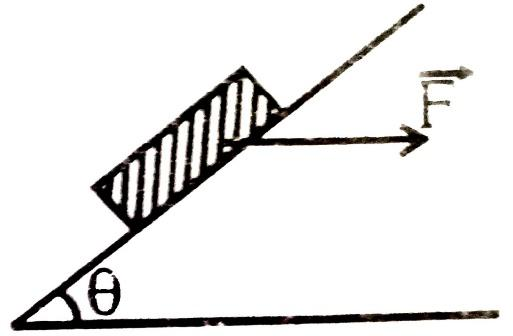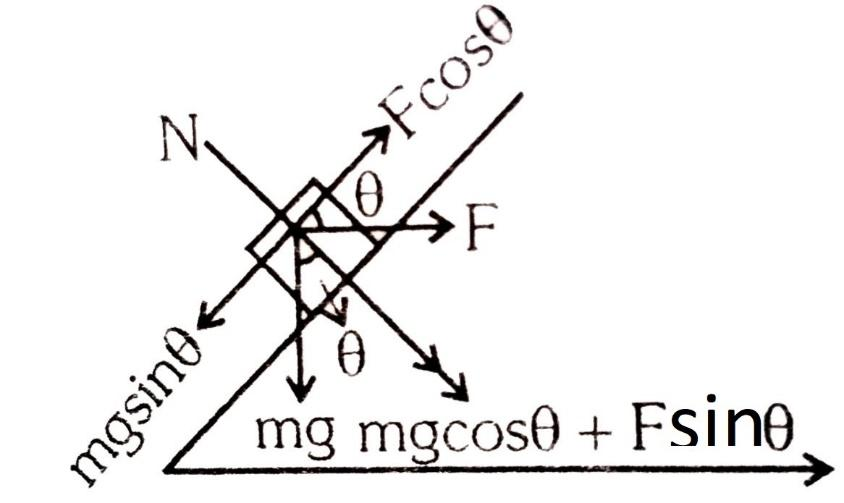
The figure shows a horizontal force $\vec F$ acting on the block of mass $M$ on an inclined plane (angle $\theta $ ). What is the normal reaction $N$ on the block?

A) $mg\,\sin \theta + F\,\cos \theta $
B) $mg\,\sin \theta - F\,\cos \theta $
C) $mg\,\cos \theta - F\sin \theta $
D) $mg\,\cos \theta + F\,\sin \theta $
Answer
219.3k+ views
Hint: Construct the diagram of the horizontal force given and also the force due to the weight of the block taken. Split these two forces into horizontal components and the vertical component to obtain the resultant force and the normal force to it.
Complete step by step solution:
It is given that the
Horizontal force acting on the block is $\vec F$
The mass of the block is $M$
The mass is at an angle of $\theta $ on the inclined plane
Since $\vec F$ is the horizontal force that acts on the block, it pushes the block to move upward on the slanting inclined plane. There will be the force which acts against it and downwards. It is formed by the combination of the weight of the block and the gravitational force of the block towards the earth. According to Newton's second law of motion, force is the product of the mass and the acceleration.
${F_w} = mg$
This force pulls the block towards down against the horizontal external force. Let us construct the diagram of the case given.

From the constructed diagram, the force $mg$divided into $mg\,\sin \theta $ and $mg\,\cos \theta $. And the horizontal force divided into $F\sin \theta $ and $F\,\cos \theta $ . If we take the normal, the answer is $mg\,\cos \theta + F\,\sin \theta $.
Thus the option (D) is correct.
Note: It is to be noted that when the vector of the force is divided into the horizontal and the vertical component, the sine of the force magnitude is taken as the vertical component of force and the cosine is taken as the horizontal component.
Complete step by step solution:
It is given that the
Horizontal force acting on the block is $\vec F$
The mass of the block is $M$
The mass is at an angle of $\theta $ on the inclined plane
Since $\vec F$ is the horizontal force that acts on the block, it pushes the block to move upward on the slanting inclined plane. There will be the force which acts against it and downwards. It is formed by the combination of the weight of the block and the gravitational force of the block towards the earth. According to Newton's second law of motion, force is the product of the mass and the acceleration.
${F_w} = mg$
This force pulls the block towards down against the horizontal external force. Let us construct the diagram of the case given.

From the constructed diagram, the force $mg$divided into $mg\,\sin \theta $ and $mg\,\cos \theta $. And the horizontal force divided into $F\sin \theta $ and $F\,\cos \theta $ . If we take the normal, the answer is $mg\,\cos \theta + F\,\sin \theta $.
Thus the option (D) is correct.
Note: It is to be noted that when the vector of the force is divided into the horizontal and the vertical component, the sine of the force magnitude is taken as the vertical component of force and the cosine is taken as the horizontal component.
Recently Updated Pages
Two discs which are rotating about their respective class 11 physics JEE_Main

A ladder rests against a frictionless vertical wall class 11 physics JEE_Main

Two simple pendulums of lengths 1 m and 16 m respectively class 11 physics JEE_Main

The slopes of isothermal and adiabatic curves are related class 11 physics JEE_Main

A trolly falling freely on an inclined plane as shown class 11 physics JEE_Main

The masses M1 and M2M2 M1 are released from rest Using class 11 physics JEE_Main

Trending doubts
JEE Main 2026: Application Form Open, Exam Dates, Syllabus, Eligibility & Question Papers

Understanding Uniform Acceleration in Physics

Derivation of Equation of Trajectory Explained for Students

Hybridisation in Chemistry – Concept, Types & Applications

Understanding the Angle of Deviation in a Prism

Understanding Collisions: Types and Examples for Students

Other Pages
JEE Advanced Marks vs Ranks 2025: Understanding Category-wise Qualifying Marks and Previous Year Cut-offs

Units And Measurements Class 11 Physics Chapter 1 CBSE Notes - 2025-26

NCERT Solutions For Class 11 Physics Chapter 8 Mechanical Properties Of Solids

Motion in a Straight Line Class 11 Physics Chapter 2 CBSE Notes - 2025-26

NCERT Solutions for Class 11 Physics Chapter 7 Gravitation 2025-26

Understanding Atomic Structure for Beginners




